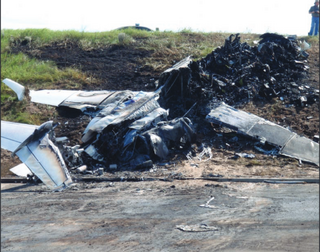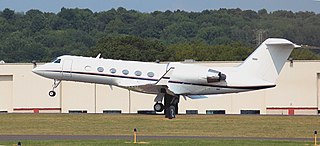
Takeoff is the phase of flight in which an aerospace vehicle leaves the ground and becomes airborne. For aircraft traveling vertically, this is known as liftoff.
In aviation, a go-around is an aborted landing of an aircraft that is on final approach or has already touched down. A go-around can either be initiated by the pilot flying or requested by air traffic control for various reasons, such as an unstabilized approach or an obstruction on the runway.

USAir Flight 5050 was a passenger flight that crashed on takeoff from LaGuardia Airport in Queens, New York. As the plane took off from LaGuardia's runway 31, the plane drifted to the left. After hearing a loud bang, the pilots attempted to reject the takeoff, but were unable to stop the plane short of the end of the runway. The plane continued past the end of the runway and plunged into Bowery Bay. Two passengers were killed.
An autobrake is a type of automatic wheel-based hydraulic brake system for advanced airplanes. The autobrake is normally enabled during takeoff and landing procedures, when the aircraft's longitudinal deceleration system can be handled by the automated systems of the aircraft itself in order to keep the pilot free to perform other tasks.
In aviation, a balanced field takeoff is a condition where the takeoff distance required (TODR) with one engine inoperative and the accelerate-stop distance are equal for the aircraft weight, engine thrust, aircraft configuration and runway condition. For a given aircraft weight, engine thrust, aircraft configuration, and runway condition, the shortest runway length that complies with safety regulations is the balanced field length.

Trans World Airlines (TWA) Flight 159 was a regularly scheduled passenger flight from New York City to Los Angeles, California, with a stopover in Cincinnati/Northern Kentucky International Airport, Kentucky, that crashed after an aborted takeoff from Cincinnati on November 6, 1967. The Boeing 707 attempted to abort takeoff when the copilot became concerned that the aircraft had collided with a disabled DC-9 on the runway. The aircraft overran the runway, struck an embankment and caught fire. One passenger died as a result of the accident.

TWA Flight 843 was a scheduled Trans World Airlines passenger flight that crashed after an aborted takeoff from John F. Kennedy International Airport to San Francisco International Airport (California) in July 1992. Despite an intense fire after the crash, the crew was able to evacuate all 280 passengers from the aircraft. There was no loss of life, although the aircraft was destroyed by the fire.

A turbine engine failure occurs when a turbine engine unexpectedly stops producing power due to a malfunction other than fuel exhaustion. It often applies for aircraft, but other turbine engines can fail, like ground-based turbines used in power plants or combined diesel and gas vessels and vehicles.

In aviation, V-speeds are standard terms used to define airspeeds important or useful to the operation of all aircraft. These speeds are derived from data obtained by aircraft designers and manufacturers during flight testing for aircraft type-certification. Using them is considered a best practice to maximize aviation safety, aircraft performance, or both.

On the night of September 19, 2008, a Learjet 60 business jet operating for Global Exec Aviation, crashed during take-off from Columbia Metropolitan Airport in South Carolina.
Engine failure on takeoff (EFTO) is a situation, when flying an aircraft, where an engine has failed, or is not delivering sufficient power, at any time between brake release and the wheels leaving the ground / V2. The phases of flight are delineated to allow simplified standard procedures for different aircraft types to be developed. If an aircraft suffered engine failure on takeoff, the standard procedure for most aircraft would be to abort the takeoff.

Delta Air Lines Flight 1288 was a regularly scheduled flight from Pensacola, Florida to Atlanta, Georgia. On July 6, 1996, the aircraft serving the flight, a McDonnell Douglas MD-88, was on takeoff roll from Runway 17 at Pensacola when it experienced an uncontained, catastrophic turbine engine failure that caused debris from the front compressor hub of the left engine to penetrate the left aft fuselage. The cause of the engine failure was found to have been a fault in the manufacture of the fan. The failure of the airline to spot the resulting crack in the blade was a contributing factor.

British Airways Flight 2276 was a scheduled international passenger service from Las Vegas to London. On 8 September 2015, the Boeing 777-200ER operating the flight suffered an uncontained engine failure and fire in the left (#1) GE90 engine during take-off from Las Vegas-McCarran International Airport, prompting an aborted take-off and the evacuation of all passengers and crew. All 170 people on board survived, but 20 were injured.

American Airlines Flight 383 was a scheduled passenger flight from O'Hare International Airport in Chicago, Illinois to Miami International Airport. On October 28, 2016, the Boeing 767-300ER operating the flight suffered an engine fire during takeoff. The crew aborted their takeoff, evacuating everyone on board, of whom 21 were injured. The plane was a write-off.

Interflug Flight 102 ended in a crash involving an Ilyushin Il-62M on 17 June 1989. The aircraft, while attempting to take off from Berlin Schönefeld Airport, East Germany, crashed into obstacles on the ground at the end of its takeoff, costing 21 lives.

Ameristar Charters Flight 9363 was a charter flight from Willow Run Airport to Washington Dulles Airport on March 8, 2017, which rejected takeoff and overran the runway. The crash was caused by a jammed elevator, which was damaged by high winds the day before the crash.

American millionaire philanthropist Lewis Katz and six others were killed in a Gulfstream IV crash in Bedford, Massachusetts, on 31 May 2014. Katz, the co-owner of The Philadelphia Inquirer and several major sports teams, had chartered the twinjet for a day trip from Atlantic City, New Jersey, to Concord, Massachusetts. In addition to several personal friends, he had also invited Edward G. Rendell, a former governor of Pennsylvania, who was unable to accept.

Tower Air Flight 41 was a scheduled domestic passenger flight from John F. Kennedy International Airport (JFK) in New York City, to Miami International Airport (MIA) in Florida. On December 20, 1995, the Boeing 747-100 operating the flight veered off the runway during takeoff from JFK. All 468 people on board survived, but 25 people were injured. The aircraft was damaged beyond repair and written off, making the accident the 25th hull loss of a Boeing 747. The National Transportation Safety Board (NTSB) concluded that the captain had failed to reject the takeoff in a timely manner.

Régional Flight 7775 was a flight from Pau Pyrénées Airport to Paris Charles de Gaulle Airport which crashed shortly after takeoff during wintry conditions. The flight was operated by Air France's regional subsidiary Régional using a Fokker 100. All passengers survived the incident but one person on the ground was killed. An investigation by the BEA determined that the cause of the accident was ice on the wings of the aircraft along with excessive rotation in the weather conditions during takeoff.
Weltzien Skypark is a privately owned, public use airport located 3 miles west of Wadsworth, Ohio, in Medina County. The airpark sits on 26 acres at an elevation of 1210 feet.














